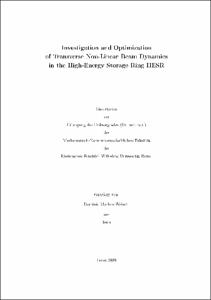Investigation and Optimization of Transverse Non-Linear Beam Dynamics in the High-Energy Storage Ring HESR

Investigation and Optimization of Transverse Non-Linear Beam Dynamics in the High-Energy Storage Ring HESR

| dc.contributor.advisor | Maier, Rudolf | |
| dc.contributor.author | Welsch, Dominic Markus | |
| dc.date.accessioned | 2020-04-15T13:28:20Z | |
| dc.date.available | 2020-04-15T13:28:20Z | |
| dc.date.issued | 29.03.2010 | |
| dc.identifier.uri | https://hdl.handle.net/20.500.11811/4554 | |
| dc.description.abstract | The High-Energy Storage Ring (HESR) is part of the upcoming Facility for Antiproton and Ion Research (FAIR) which is planned as a major extension to the present facility of the Helmholtzzentrum für Schwerionenforschung (GSI) in Darmstadt. The HESR will provide antiprotons in the momentum range from 1.5 to 15 GeV/c for the internal target experiment PANDA. The demanding requirements of PANDA in terms of beam quality and luminosity together with a limited production rate of antiprotons call for a long beam life time and a minimum of beam loss. Therefore, an effective closed orbit correction and a sufficiently large dynamic aperture of the HESR are crucial. With this thesis I present my work on both of these topics. The expected misalignments of beam guiding magnets have been estimated and used to simulate the closed orbit in the HESR. A closed orbit correction scheme has been developed for different ion optical settings of the HESR and numerical simulations have been performed to validate the scheme. The proposed closed orbit correction method which uses the orbit response matrix has been benchmarked at the Cooler Synchrotron COSY of the Forschungszentrum Jülich. A chromaticity correction scheme for the HESR consisting of sextupole magnets has been developed to reduce tune spread and thus to minimize the emittance growth caused by betatron resonances. The chromaticity correction scheme has been optimized through dynamic aperture calculations. The estimated field errors of the HESR dipole and quadrupole magnets have been included in the non-linear beam dynamics studies. Investigations concerning their optimization have been carried out. The ion optical settings of the HESR have been improved using dynamic aperture calculations and the technique of frequency map analysis. The related diffusion coefficient was also used to predict long-term stability based on short-term particle tracking. With a reasonable reduction of the quadrupole magnets field errors and a different choice of tunes, the dynamic aperture was improved by roughly a factor two. The inner area of the dynamic aperture where the particle motion is stable on a long-term scale was increased to include more than 3 sigma beam size and the specified maximum closed orbit deviations. | en |
| dc.language.iso | eng | |
| dc.rights | In Copyright | |
| dc.rights.uri | http://rightsstatements.org/vocab/InC/1.0/ | |
| dc.subject | Hoch-Energie-Speicher-Ring | |
| dc.subject | HESR | |
| dc.subject | dynamische Apertur | |
| dc.subject | nicht-lineare Strahldynamik | |
| dc.subject | Chromatizitätskorrektur | |
| dc.subject | Orbitkorrektur | |
| dc.subject | facility for antiproton and ion research | |
| dc.subject | fair | |
| dc.subject | high-energy storage ring | |
| dc.subject | non-linear beam dynamics | |
| dc.subject | closed orbit correction | |
| dc.subject | chromaticity correction | |
| dc.subject | dynamic aperture | |
| dc.subject | frequency map analysis | |
| dc.subject.ddc | 530 Physik | |
| dc.title | Investigation and Optimization of Transverse Non-Linear Beam Dynamics in the High-Energy Storage Ring HESR | |
| dc.type | Dissertation oder Habilitation | |
| dc.publisher.name | Universitäts- und Landesbibliothek Bonn | |
| dc.publisher.location | Bonn | |
| dc.rights.accessRights | openAccess | |
| dc.identifier.urn | https://nbn-resolving.org/urn:nbn:de:hbz:5N-20826 | |
| ulbbn.pubtype | Erstveröffentlichung | |
| ulbbnediss.affiliation.name | Rheinische Friedrich-Wilhelms-Universität Bonn | |
| ulbbnediss.affiliation.location | Bonn | |
| ulbbnediss.thesis.level | Dissertation | |
| ulbbnediss.dissID | 2082 | |
| ulbbnediss.date.accepted | 10.03.2010 | |
| ulbbnediss.fakultaet | Mathematisch-Naturwissenschaftliche Fakultät | |
| dc.contributor.coReferee | Bisplinghoff, Jens |
Dateien zu dieser Ressource
Das Dokument erscheint in:
-
E-Dissertationen (4373)




